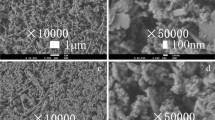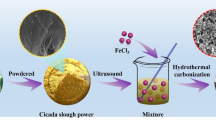Abstract
Wastewater containing quinoline has become a common pollutant in water and soil environments, which poses a threat to human health due to its carcinogenicity, teratogenicity, and mutagenicity. Quinoline’s stability and toxicity hinders its degradation by conventional physicochemical and biological methods. In this contribution, Fe-Co-Bi/kaolin particle electrodes were prepared for the efficient degradation of quinoline in wastewater, and characterized by using scanning electron microscope, X-ray diffraction, pyridine-IR, Brunauer–Emmett–Teller, X-ray photoelectron spectroscopy, and four-probe resistivity test. Parameters affecting the degradation efficiency were optimized to be the particle electrode dosage of 40 g/L, pH 3.5, H2O2 addition of 67.6 mmol/L, electrical conductivity of 12.7 ms/cm, and voltage of 20 V. The constructed three-dimensional catalytic particle electrode system (3D-CPE) achieved 92.1% removal rate of chemical oxygen demand (COD) under the optimal conditions. Hydroxyl radicals (•OH) generated in the 3D-CPE process were identified by radical scavenging tests and electron spin response analysis. To unravel the degradation mechanism, the intermediate products were identified by using high performance liquid chromatography-mass spectrometry. The degradation mechanism was discussed with the help of theoretical calculation.









Similar content being viewed by others
Availability of data and materials
The authors confirm that the data supporting the findings of this study are available within the article.
References
Cao Y, Qiu W, Zhao Y, Li J, Jiang J, Yang Y, Pang S-Y, Liu G (2020) The degradation of chloramphenicol by O3/PMS and the impact of O3-based AOPs pre-oxidation on dichloroacetamide generation in post-chlorination. Chem Eng J 401:126146
Chellal K, Bachari K, Sadi F (2014) Iron incorporated mesoporous molecular sieves synthesized by a microwave-hydrothermal process and their application in catalytic oxidation. J Cluster Sci 25:523–539
Chen Y, Li N, Zhang Y, Zhang L (2014) Novel low-cost Fenton-like layered Fe-titanate catalyst: preparation, characterization and application for degradation of organic colorants. J Colloid Interface 422:9–15
Chen J, Peng G, Zheng W, Zhang W, Guo L, Wu X (2020) Excellent performance of one-pot synthesized Fe-containing MCM-22 zeolites for the selective catalytic reduction of NOx with NH3. Cat Sci Technol 10:6583–6598
ErsÖz G (2014) Fenton-like oxidation of reactive black 5 using rice husk ash based catalyst. Appl Catal B 147:353–358
Ganiyu SO, de Araújo MJG, de Araújo Costa ECT, Santos JEL, dos Santos EV, Martínez-Huitle CA, Pergher SBC (2021) Design of highly efficient porous carbon foam cathode for electro-Fenton degradation of antimicrobial sulfanilamide. Appl Catal B Environ 283:119652
He H, Zhou Z (2017) Electro-Fenton process for water and wastewater treatment. CRC Crit Rev Environ Control 47:2100–2131
He W, Ma Q, Jing W, Jie Y, Bao W, Ma H, Amrane A (2014) Preparation of novel kaolin-based particle electrodes for treating methyl orange wastewater. Appl Clay Sci 99:178–186
Hong L, Hai Y, Jia C, Hu C, Yang Z (2021) Three-dimensional particle electrode system treatment of organic wastewater: a general review based on patents. J Clean Prod 308:127324
Huang C, Wu P, Guo Y, Guo Y (2020) Facile synthesis of mesoporous kaolin catalyst carrier and its application in deep oxidative desulfurization. Microporous Mesoporous Mater 306:110415
Kubo D, Kawase Y (2018) Hydroxyl radical generation in electro-Fenton process with in situ electro-chemical production of Fenton reagents by gas-diffusion-electrode cathode and sacrificial iron anode. J Clean Prod 203:685–695
Labiadh L, Oturan MA, Panizza M, Ben Hamadi N, Ammar S (2015) Complete removal of AHPS synthetic dye from water using new electro-Fenton oxidation catalyzed by natural pyrite as heterogeneous catalyst. J Hazard Mater 297:34–41
Li M, Zhao F, Sillanpää M, Meng Y, Yin D (2015) Electrochemical degradation of 2-diethylamino-6-methyl-4-hydroxypyrimidine using three-dimensional electrodes reactor with ceramic particle electrodes. Sep Purif Technol 156:588–595
Li M, Qin X, Cui J, Guo R, Guo C, Wang Z, Li T (2021) Three-dimensional Electro-Fenton degradation for fulvic acids with Cu-Fe bimetallic aerogel-like carbon as particle electrode and catalyst: electrode preparation, operation parameter optimization and mechanism. J Environ Chem Eng 9:105573
Li M, Ren G, Yang W, Wang F, Ma N, Fan X, Pan Q (2021) Modulation of High-Spin Co(II) in Li/Co-MOFs as Efficient Fenton-like Catalysts. Inorg Chem 60:12405
Ling C, Zhang Y, Gan L, Hua X, Rittmann BE (2014) Internal loop photo-biodegradation reactor used for accelerated quinoline degradation and mineralization. Biodegradation 25:587
Liu S, Wang Z, Li J, Zhao C, He X, Yang G (2018) Fabrication of slag particle three-dimensional electrode system for methylene blue degradation: characterization, performance and mechanism study. Chemosphere 213:377–383
Liu J, Zhang Q, Tian X, Hong Y, Nie Y, Su N, Jin G, Zhai Z, Fu C (2020) Highly efficient photocatalytic degradation of oil pollutants by oxygen deficient SnO2 quantum dots for water remediation. Chem Eng J 404:127146
Liu X, Wang S, Yang H, Liu Z, Wang Y, Meng F, Ma J, Izosimova OS (2020) Characterization of a doped MnO2Al2O3 catalyst and its application inmicrobubble ozonation for quinoline degradation. Ozone Sci Eng 43:1–12
Liu Y, Zhao Y, Wang J (2021) Fenton/Fenton-like processes with in-situ production of hydrogen peroxide/hydroxyl radical for degradation of emerging contaminants: advances and prospects. J Hazard Mater 404:124191
Luo Y, Yue X, Wei P, Zhou A, Alimzhanova S (2020) A state-of-the-art review of quinoline degradation and technical bottlenecks. Sci Total Environ 747:141136
Nidheesh PV, Gandhimathi R (2012) Trends in electro-Fenton process for water and wastewater treatment: an overview. Desalination 299:1–15
Ouiriemmi I, Karrab A, Oturan N, Pazos M, Rozales E, Gadri A, Sanromán MÁ, Ammar S, Oturan MA (2017) Heterogeneous electro-Fenton using natural pyrite as solid catalyst for oxidative degradation of vanillic acid. J Electroanal Chem 797:69–77
Peller J, Wiest O, Kamat PV (2001) Sonolysis of 2,4-dichlorophenoxyacetic acid in aqueous solutions. Evidence for OH-Radical-Mediated Degradation. J Phys Chem A 105:3176–3181
Santos A, Yustos P, Quintanilla A, García-Ochoa F, Rodríguez J (2004) Evolution of toxicity upon wet catalytic oxidation of phenol. Environ Sci Technol 38:133–138
Shen C, Wen X, Fei Z, Liu Z, Mu Q (2019) Visible-light-driven activation of peroxymonosulfate for accelerating ciprofloxacin degradation using CeO2/Co3O4 p-n heterojunction photocatalysts. Chem Eng J 391:123612
Song B, Wang Z, Li J, Ma Y (2020) Preparation and electrocatalytic properties of kaolin/steel slag particle electrodes. Catal Commun 148:106177
Sun Y, Li P, Zheng H, Zhao C, Xiao X, Xu Y, Sun W, Wu H, Ren M (2017) Electrochemical treatment of chloramphenicol using Ti-Sn/γ-Al2O3 particle electrodes with a three-dimensional reactor. Chem Eng J 308:1233–1242
Tang S, Lu N, Li J, Shang K, Wu Y (2013) Improved phenol decomposition and simultaneous regeneration of granular activated carbon by the addition of a titanium dioxide catalyst under a dielectric barrier discharge plasma. Carbon 53:380–390
Tian H, Jiao J, Tian H, He H, Zha F, Guo X, Tang X, Chang Y (2021) Methanol aromatization over Zn-modified HZSM-5 catalysts derived from ZIF-8. Fuel 302:121224
Tong M, Yuan S, Ma S, Jin M, Liu D, Cheng D, Liu X, Gan Y, Wang Y (2015) Production of abundant hydroxyl radicals from oxygenation of subsurface sediments. Environ Sci Technol 50:4890–4891
Wang J, Okumura K, Jaenicke S, Chuah G-K (2015) Post-synthesized zirconium-containing beta zeolite in Meerwein–Ponndorf–Verley reduction: pros and cons. Appl Catal A Gen 493:112–120
Wang YP, Liu YH, Ruan R, Liu ST, Wen PW, Wan YQ (2016) Preparation and characterization of ZrO2 polycrystalline ceramic foam catalyst for production of biodiesel. Synth React Inorg Met-Org Chem 46:1506–1512
Xiao J, Chen J, Ou Z, Lai J, Yu T, Wang Y (2021) N-doped carbon-coated Fe 3 N composite as heterogeneous electro-Fenton catalyst for efficient degradation of organics. Chin J Catal 42:953–962
Xiaochao G, Xuebin L, Jin T, Xiaoyun L, Bin Z, Xujing Z, Jin X (2018) Degradation of folic acid wastewater by electro-Fenton with three-dimensional electrode and its kinetic study. R Soc Open Sci 5:170926
Xie Y, Wang X, Tong W, Hu W, Li P, Dai L, Wang Y, Zhang Y (2020) Fe x P/biochar composites induced oxygen-driven Fenton-like reaction for sulfamethoxazole removal: performance and reaction mechanism. Chem Eng J 396:125321
Xiong Y, T. Karlsson H (2002) An experimental investigation of chemical oxygen demand removal from the wastewater containing oxalic acid using three-phase three-dimensional electrode reactor. Adv Environ Res 7:139–145
Zhang B, Hou Y, Yu Z, Liu Y, Huang J, Qian L, Xiong J (2018) Three-dimensional electro-Fenton degradation of Rhodamine B with efficient Fe-Cu/kaolin particle electrodes: electrodes optimization, kinetics, influencing factors and mechanism. Sep Purif Technol 210:60–68
Zhang W, Xie D, Li X, Ye W, Jiang X, Wang Y, Liang W (2018b) Electrocatalytic removal of humic acid using cobalt-modified particle electrodes. Appl Catal A 559:75–84
Zhang L, Wang Z, Hu C, Shi B (2019) Enhanced photocatalytic performance by the synergy of Bi vacancies and Bi0 in Bi0-Bi2-δMoO6. Appl Catal B 257:117785
Zhang W, Chen J, Wang J, Cui CX, Zhang Y (2021) Impact of active chlorines and OH radicals on degradation of quinoline using the bipolar electro-Fenton process. Water 13:128
Zhou M, Li W, Du Y, Kong D, Wang Z, Meng Y, Sun X, Yan T, Kong D, You J (2016) Hydrothermal synthesis of bismuth ferrite Fenton-like catalysts and their properties. J Nanopart Res 18:346
Zhu G, Ge R, Qu F, Gu D, Asiri AM, Yao Y, Sun X (2017) In situ surface derivation of an Fe–Co–Bi layer on an Fe-doped Co3O4 nanoarray for efficient water oxidation electrocatalysis under near-neutral conditions. J Mater Chem A 5:6388–6392
Funding
This research was supported by the National Natural Science Foundation of China (no. 51802082), and by the Program for Science & Technology Innovation Talents in Universities of Henan Province (21HATITO16).
Author information
Authors and Affiliations
Contributions
Jun Chen: conceptualization, methodology, formal analysis. Boding Zhang: data curation, writing—original draft, and writing—review and editing. Bingxing Wang: writing—review and editing, and visualization. Wenlong Zhang: methodology, investigation, resources, and supervision. Jichao Wang: resources and funding acquisition. Chengxing Cui: data curation and investigation. Songlin Wang: investigation and visualization.
Corresponding author
Ethics declarations
Ethics approval and consent to participate
Not applicable.
Consent for publication
The authors confirm that the final version of the manuscript has been reviewed, approved, and consented for publication by all authors.
Competing interests
The authors declare no competing interests.
Additional information
Responsible Editor: Ricardo A. Torres-Palma
Publisher's note
Springer Nature remains neutral with regard to jurisdictional claims in published maps and institutional affiliations.
Supplementary Information
Below is the link to the electronic supplementary material.
Rights and permissions
Springer Nature or its licensor holds exclusive rights to this article under a publishing agreement with the author(s) or other rightsholder(s); author self-archiving of the accepted manuscript version of this article is solely governed by the terms of such publishing agreement and applicable law.
About this article
Cite this article
Chen, J., Zhang, B., Wang, B. et al. Heterogeneous electro-Fenton using three-dimension Fe-Co-Bi/kaolin particle electrodes for degradation of quinoline in wastewater. Environ Sci Pollut Res 30, 1399–1412 (2023). https://doi.org/10.1007/s11356-022-22232-4
Received:
Accepted:
Published:
Issue Date:
DOI: https://doi.org/10.1007/s11356-022-22232-4




